In this second cryptocurrency put option example, we’re going to sell a bitcoin put option. Unlike the previous example where we let the position expire, with today’s example we are not going to let this option expire. We will initially sell the put, let some time pass, then close the position ourselves before expiry by buying it back.
Hopefully we will manage to buy it back for a lower price than we sell it for to lock in a profit, however we will close it whether it’s currently in profit or not.
Current price
Let’s take a quick look at the current bitcoin price. This is a chart of the bitcoin price on Coinbase.
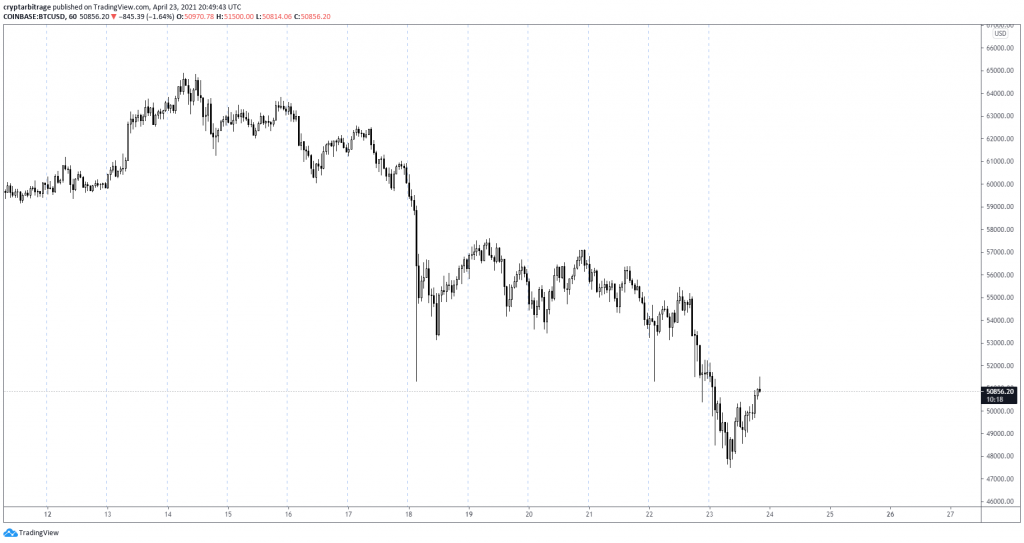
This is a one hour chart, so each candle represents one hour. Today is Friday the 23rd April 2021, and bitcoin is trading at about $50,856 on Coinbase. The price of bitcoin has been decreasing at varying speeds for a little over a week, but managed to find some support earlier today. Let’s say we have a view that now it has found support, bitcoin will remain above $50,000 for the next day or so. To capitalise on this view if we are correct, we’re going to sell a bitcoin put option with a strike price of $50,000, that expires tomorrow morning on Saturday the 24nd April.
However as we mentioned, we are not going to let this put option expire. We will hold it for a few hours and then close it no matter what.
Back to Deribit
Let’s head back over to the Deribit option chain. As you can see in the top left, I have the 24th of April option chain expanded, so every option we can currently see expires tomorrow at 0800 UTC. We want the $50,000 strike, which we can find in the middle column. And we want the put so we move right from here.
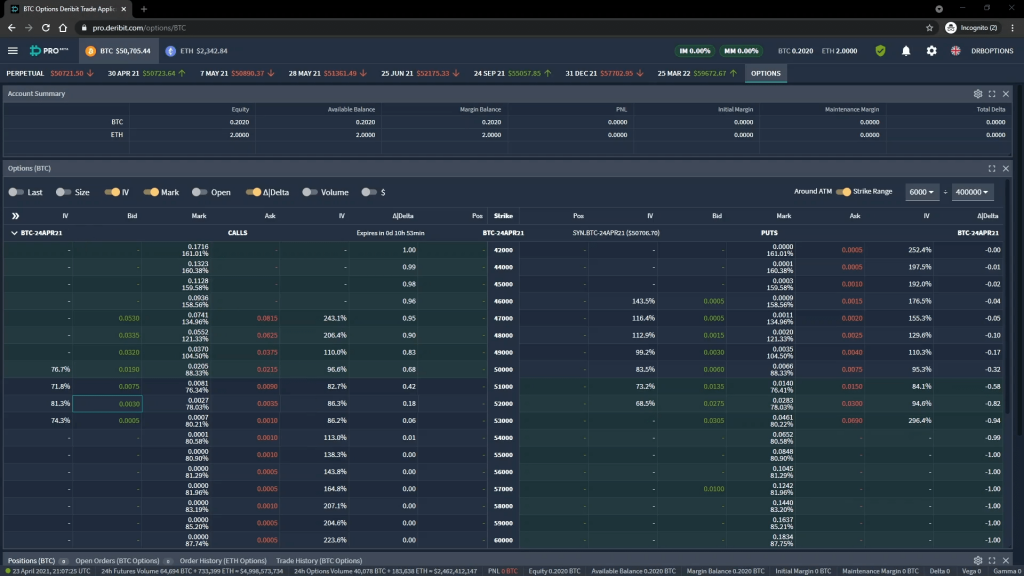
The current best bid is shown in the bid column in green, and the current best ask is shown in the ask column in red. These prices are an amount of bitcoin. For example a price of 0.006 means 0.006 BTC, or 0.6% of a bitcoin.
I also have the mark price column shown in between the bid and ask columns. The mark price is not a tradable price, but is what Deribit risk management is currently valuing each option at for margining purposes.
The option order form
We can click the $50,000 put in the option chain, which brings up the option order form for this option, includes the orderbook of bids and asks on the right.
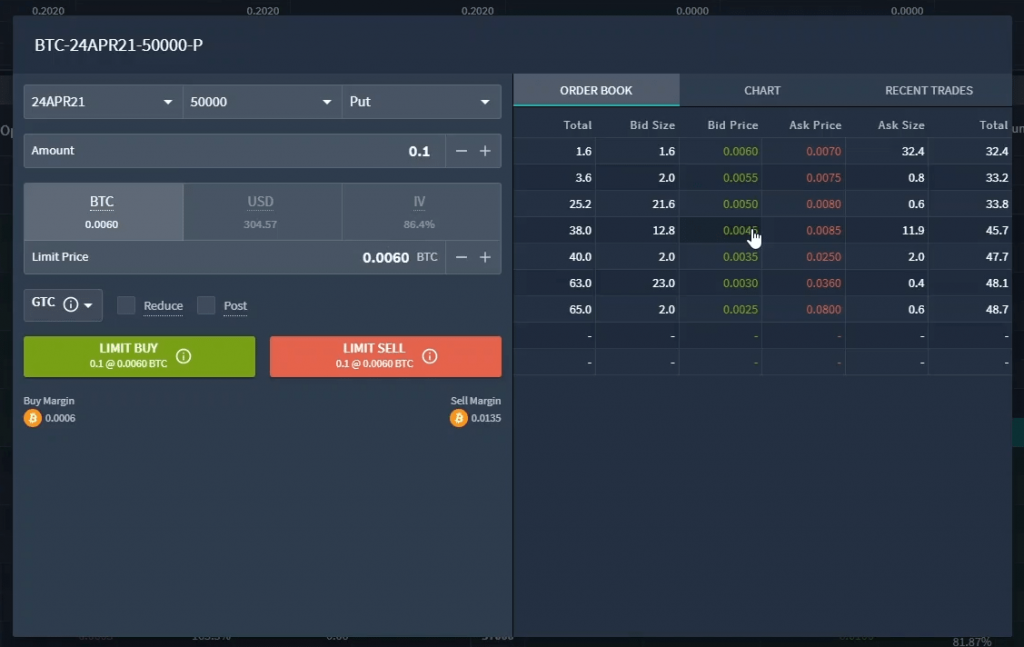
As we want to sell this $50,000 put option, it is the current bids that we are interested in. The current best bid for this option is an order to buy 1.6 contracts for a price of 0.006 BTC per contract. For today’s example we will sell into this order with a quantity of 1, meaning we will be short this put option with a notional size of 1 bitcoin.
Once we’ve entered the ‘Amount’ of 1, and checked the price is correct, we can click the SELL button. This will bring up the order confirmation screen, where we can check everything has been entered correctly. Everything is correct here, so I will click the SELL button to create the sell order.
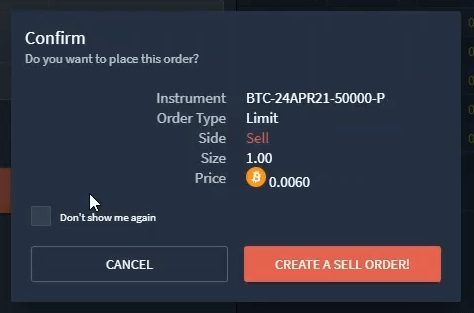
There was a buy order already in the order book at the price we selected so our order executes immediately, as expected. We can scroll down to the positions table to see our short put sitting in the account.
What could happen
Even though we’re going to close this option early, let’s take a quick look at the PNL chart for this option if we were to hold until expiry.
We have all the option parameters I just mentioned:
-The underlying asset is bitcoin
-The option type is put
-The expiry date is 24th April 2021
-The strike price is $50,000
-The option price (or premium) is 0.006 BTC per contract
The fee was also 0.0003 BTC so we will use 0.0057 BTC as the total collected.
PNL Chart
Given all the parameters we just covered, this is the PNL chart at expiry for this option position.

For any price of bitcoin above our strike price of $50,000, we would make the maximum possible profit. This maximum profit is limited to the premium we collected, minus the fees. We collected a premium of 0.006 BTC per contract, and the fees were 0.0003 BTC per contract. This gives us a total credit per contract of 0.0057 BTC. As the contract multiplier is 1 and we sold 1 contract, this is a total maximum profit of 0.0057 BTC.
If bitcoin is any price below our strike price of $50,000 at expiry, we can calculate our profit/loss using the formula from lecture 6.2:
=(Premium – ((Strike Price – BTC Price)/BTC Price))*Position Size
Except instead of just using the premium collected per contract, we can use our total credit per contract including the fee. We’ve also added the position size multiplier for completeness, but in this case the number of contracts is just 1, so it will not affect the calculation.
The profit/loss line decreasing to the left of our strike price is just this same formula plotted for each underlying price of bitcoin at expiry.
PNL Example
As an example, if the price of bitcoin moved down to $47,000 at expiry, we could calculate our profit as:
=(.0057 – ((50000 – 47000)/47000))*1
= -0.05812979 BTC
Notice how this loss is far larger than the credit we collected. As we covered in lecture 6.5, the maximum loss of a short put option is not capped when measured in bitcoin, so it is possible to lose far more than was collected in premium.
Breakeven
In lecture 6.3, we gave the formula for the breakeven point of a cryptocurrency put option as:
Cryptocurrency Put Option Breakeven = Strike Price/(1 + Premium)
As with the profit calculations, instead of using just the premium paid, we will use the total cost including fees, which is 0.00057 BTC per contract. The breakeven point is then calculated as:
= 50000/(1 + 0.0057) = $49,716.61
This is the point at which the profit/loss line crosses the x axis.
What actually happened
So that’s what could happen if we allowed the option to expire. However, we are not going to hold this one to expiry, we are going to close this option early instead.
Closing the trade
Our short option position can be seen in the option chain. We are currently short this option with a quantity of 1. To close this early, we just need to buy back the exact same option with the exact same quantity. So we will be executing a buy order for the amount of 1.
We can bring up the order form for this option by clicking on it in the option chain. Due to the decrease in the bitcoin price since we opened the position, this put option’s value has roughly doubled. As we are short this means we will be taking a loss on this.
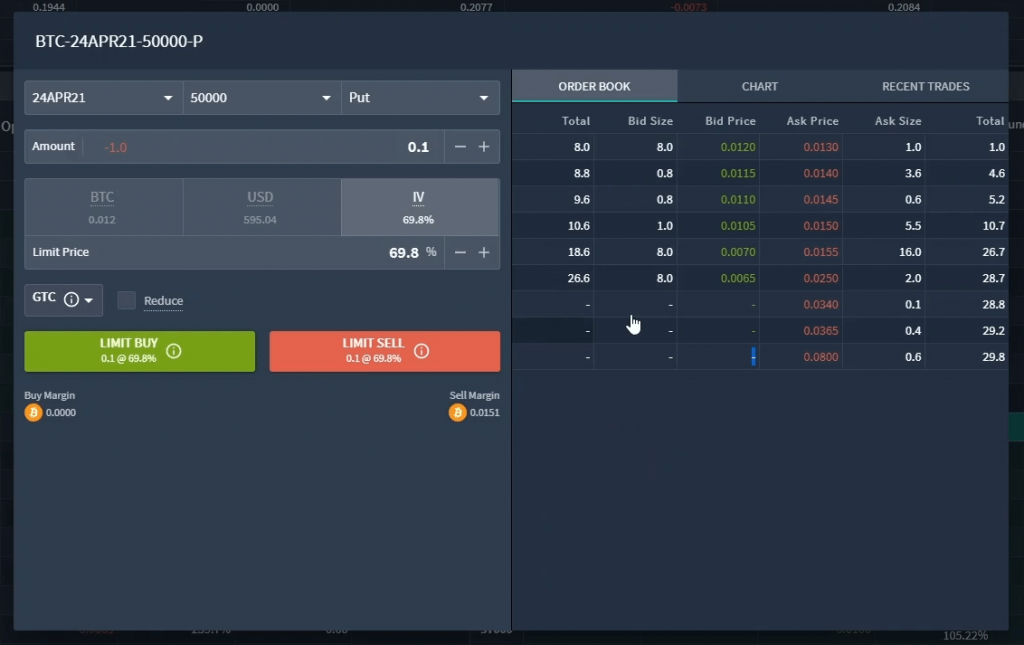
We want to buy this option back so it is the asks that we are concerned with. The best ask is currently for a price of 0.013 BTC. As we initially sold the option for just 0.006 BTC (minus fees), this will represent a loss for us, because we are having to pay more than twice the amount we initially collected to buy it back.
To buy it back and close the position, we just enter our amount of 1, and our price of 0.013 BTC, then click the BUY button. This brings up the order confirmation screen for us to check. Everything looks good so let’s click the BUY button.
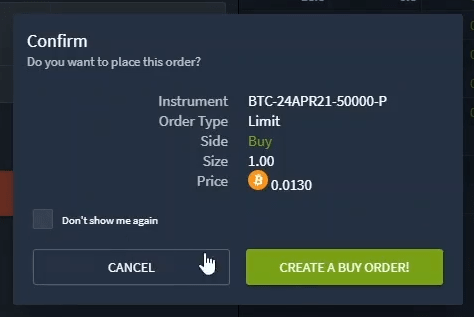
There was an order already in the order book at the price we selected so our order executes immediately, as expected, and we get the pop up in the top right showing the execution. If we scroll down to the positions table we can see that the option has been closed and we no longer have any positions open in this account. What happens between now and expiry is no longer relevant to us, as we have completely closed the option position.
The Transaction Log
If we go to the menu, and click ‘Transaction Log’, we have access to every transaction in the account.

We can see the transaction where we initially sold the option here. The option details can be seen in the instrument column. It was a sell order to open the position. The amount was 1, but as this is a short, the position size was negative 1, and we can see the total change to our account in the ‘Change’ column which was 0.0057 BTC including the fee. As this is a positive amount in green, this means our cash balance was increased by this amount, because we are paid a premium for selling the option.
In the row above is the transaction where we close this position by buying the option back. The same option details can be seen in the instrument column. It was a buy order to close the position. The amount was 1, but this time it reduces our position to zero. And again in the ‘Change’ column we can see the change to our balance. This time we paid 0.013 BTC to buy the option back. With the fee included this totals a 0.0133 BTC reduction to our cash balance.
So our opening sell transaction generated a 0.0057 BTC credit, and our closing buy transaction generated a debit of 0.0133 BTC. This means the profit/loss for this trade is calculated as:
0.0057 – 0.0133 = -0.0076 BTC
So we made a loss of 0.0076 BTC.
That’s it, this trade is complete. What happens to the value of this option at expiry has no effect on our account because we have closed our position early.
Outro
Hopefully these first two cryptocurrency put option examples have helped you see how the topics discussed in section 6 apply in the real world. And also that despite the little bit of extra knowledge required, making the jump over from traditional options doesn’t have to be too difficult.
As was mentioned at the end of section 4, Deribit also has a test website where you can try out all of their products in a test environment without risking any of your funds. This can be extremely useful for getting over that initial knowledge gap, because you can feel free to try out different things, buying and selling both puts and calls, without worrying about losing and real funds.
These first few sections of the course have hopefully got you up to a point where you understand what call options and put options are, and the basics of how to place an order to open and close each. Building on this foundation, we will move onto some slightly more advanced topics like volatility, option pricing and the option Greeks.
Before that though, the next and last part of this section is a quiz to test how much you’ve remembered so far about cryptocurrency put options, but feel free to search back if you need to refresh your knowledge.
To complete this final section and whole course you must take the quiz below:

